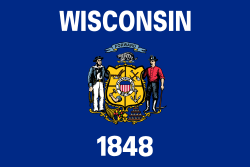#0excludeGlossary
Wisconsin is a state in the Upper Midwest and Great Lakes regions of the United States. It borders Minnesota to the west, Iowa to the southwest, Illinois to the south, Lake Michigan to the east, Michigan to the northeast, and Lake Superior to the north. With a population of about 6 million and an area of about 65,500 square miles, Wisconsin is the 20th-largest state by population and the 23rd-largest by area. It has 72 counties. The state's most populous city is Milwaukee. Its capital and second-most populous city is Madison; other urban areas include Green Bay and the Fox Cities.
Wisconsin | |
|---|---|
| Nicknames: Badger State, America's Dairyland | |
| Motto: Forward | |
| Anthem: "On, Wisconsin!" | |
 Location of Wisconsin within the United States | |
| Country | United States |
| Before statehood | Wisconsin Territory |
| Admitted to the Union | May 29, 1848 (30th) |
| Capital | Madison |
| Largest city | Milwaukee |
| Largest county or equivalent | Milwaukee County |
| Largest metro and urban areas | Milwaukee |
| Government | |
| • Governor | Tony Evers (D) |
| • Lieutenant Governor | Sara Rodriguez (D) |
| Legislature | Wisconsin Legislature |
| • Upper house | Senate |
| • Lower house | Assembly |
| Judiciary | Wisconsin Supreme Court |
| U.S. senators |
|
| U.S. House delegation |
|
| Area | |
• Total | 65,500 sq mi (169,640 km2) |
| • Land | 54,153 sq mi (140,256 km2) |
| • Water | 11,345 sq mi (29,384 km2) 17% |
| • Rank | 23rd[1] |
| Dimensions | |
| • Length | 315 mi (507 km) |
| • Width | 265 mi (427 km) |
| Elevation | 1,050 ft (320 m) |
| Highest elevation | 1,952 ft (595 m) |
| Lowest elevation | 577 ft (176 m) |
| Population (2024) | |
• Total | |
| • Rank | 20th |
| • Density | 108.8/sq mi (42.0/km2) |
| • Median household income | $74,600 (2023) |
| • Income rank | 26th |
| Demonyms | Wisconsinite, Cheesehead (colloquial) |
| Language | |
| • Official language | None |
| • Spoken language |
|
| Time zone | UTC– 06:00 (Central) |
| • Summer (DST) | UTC– 05:00 (CDT) |
| USPS abbreviation | WI |
| ISO 3166 code | US-WI |
| Traditional abbreviation | Wis., Wisc. |
| Latitude | 42° 30' N to 47° 05′ N |
| Longitude | 86° 46′ W to 92° 54′ W |
| Website | www |
seat, Capital.Wisconsin's geography is diverse, with dense forests in the north (including Chequamegon–Nicolet National Forest), rugged unglaciated hills in the western Driftless Area, and wooded plains, lowlands, and farms stretching from the interior east to Lake Michigan. Wisconsin has the third-longest Great Lakes coastline, after Ontario and Michigan. At the time of European contact, the area was inhabited by Algonquian and Siouan nations, and today it is home to eleven federally recognized tribes. Originally part of the Northwest Territory, it was admitted as a state in 1848. During the 19th and early 20th centuries, many European settlers entered the state, mostly from Germany and Scandinavia. Wisconsin remains a center of German American and Scandinavian American culture, particularly in its cuisine, with foods such as bratwurst and kringle.
Wisconsin is one of the nation's leading dairy producers and is known as "America's Dairyland"; it is particularly famous for its cheese. The state is also famous for its breweries, with beer in Milwaukee a longstanding industry. Wisconsin has some of the nation's most permissive alcohol laws and is known for its drinking culture. Its economy is dominated by manufacturing, healthcare, information technology, and agriculture—specifically dairy, cranberries, and ginseng. Tourism is also a major contributor to its economy. The gross domestic product in 2020 was $348 billion. Wisconsin is home to one UNESCO World Heritage Site, comprising two of the most significant buildings designed by Wisconsin-born architect Frank Lloyd Wright: his studio at Taliesin and his Jacobs I House. Politically, it is considered a swing state in national and statewide elections; the Republican Party was founded in Wisconsin in 1854.







